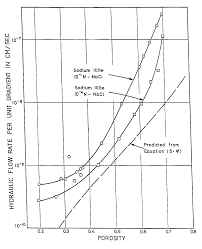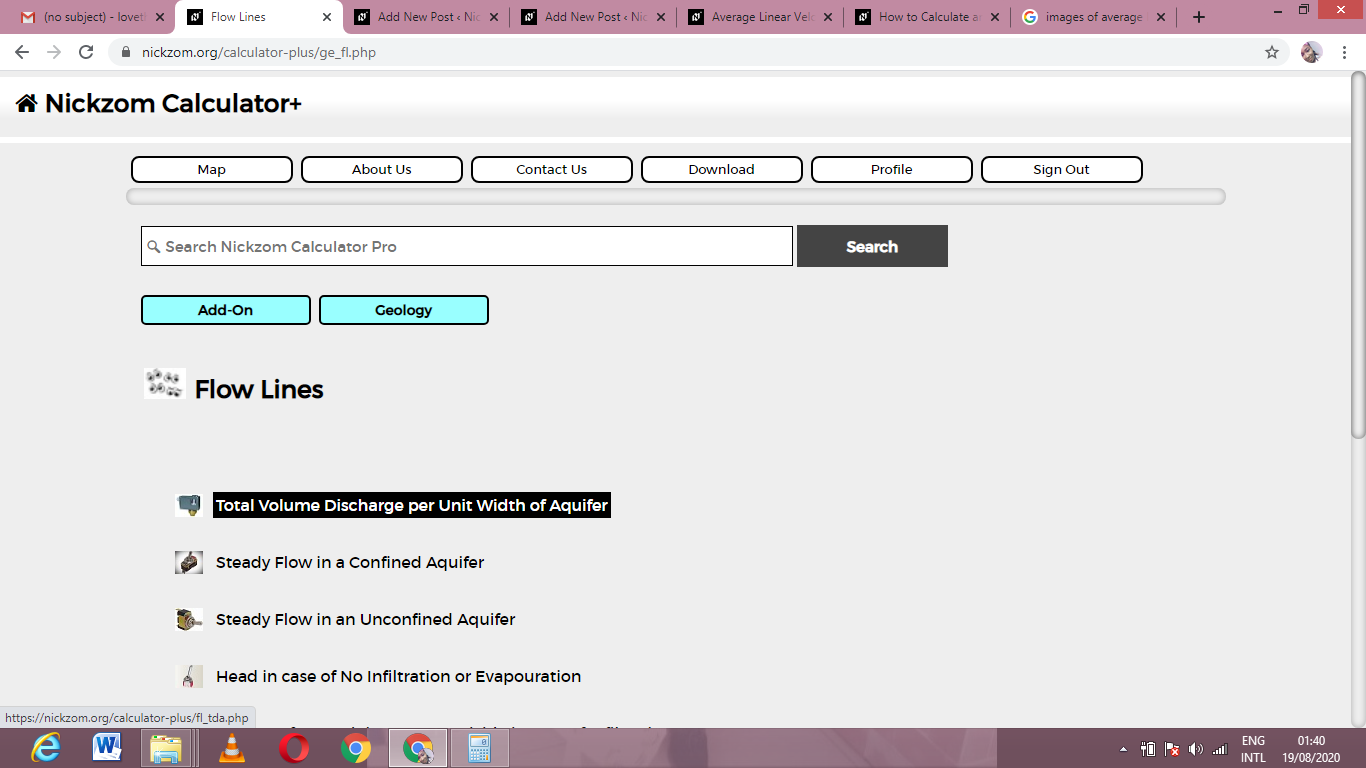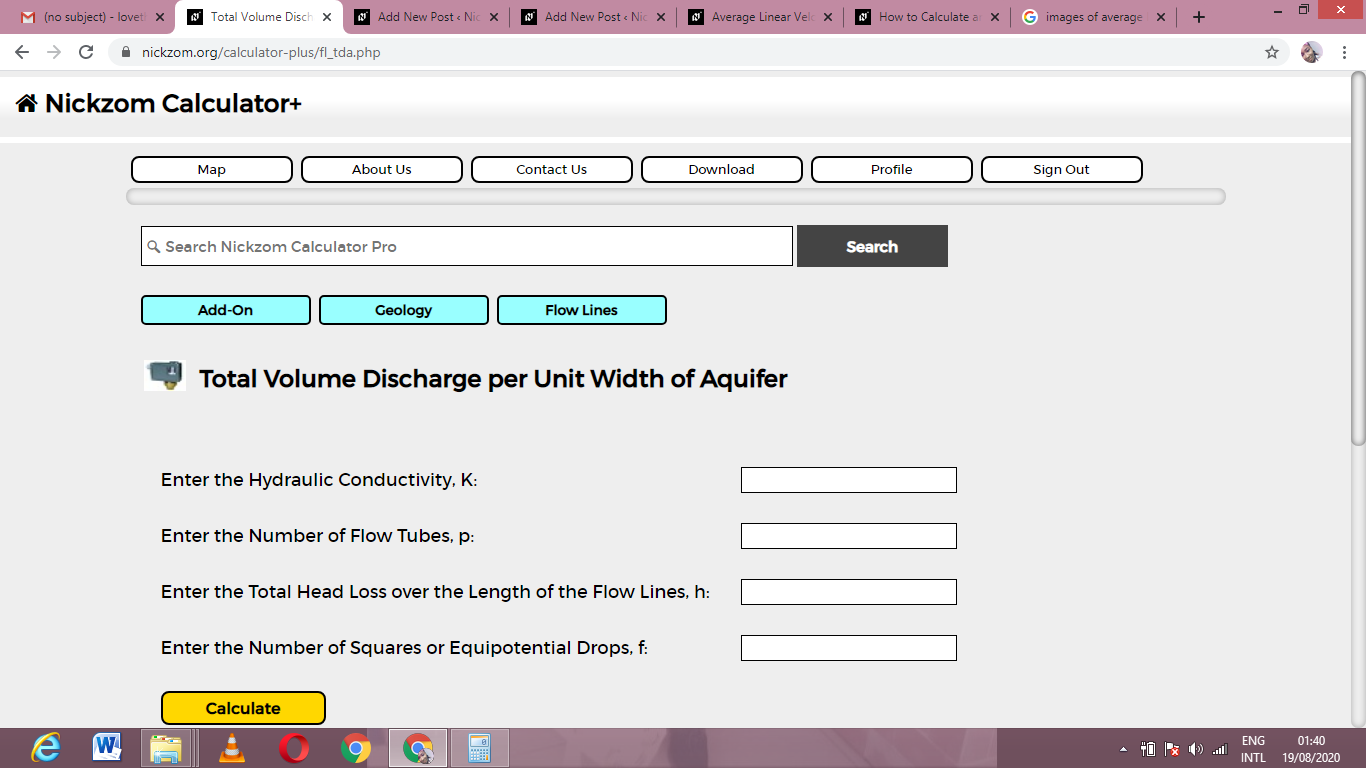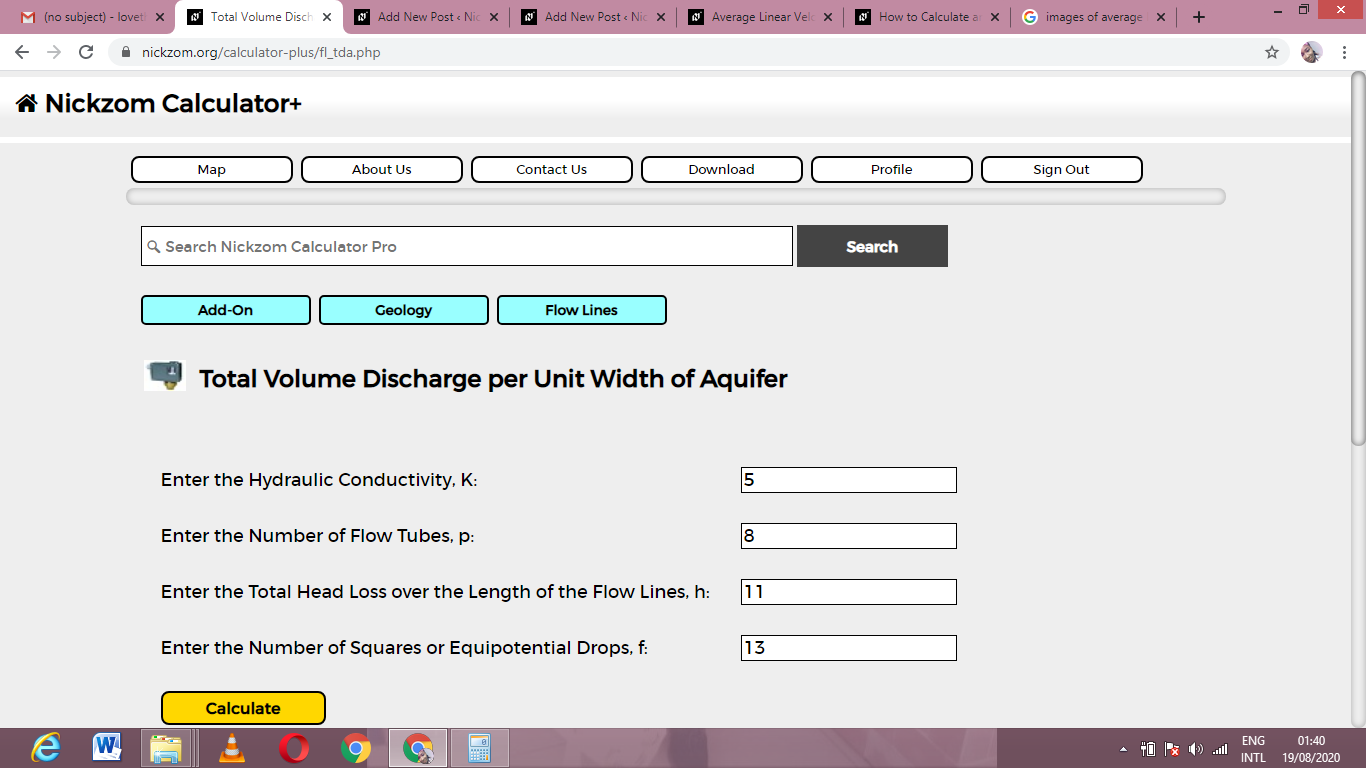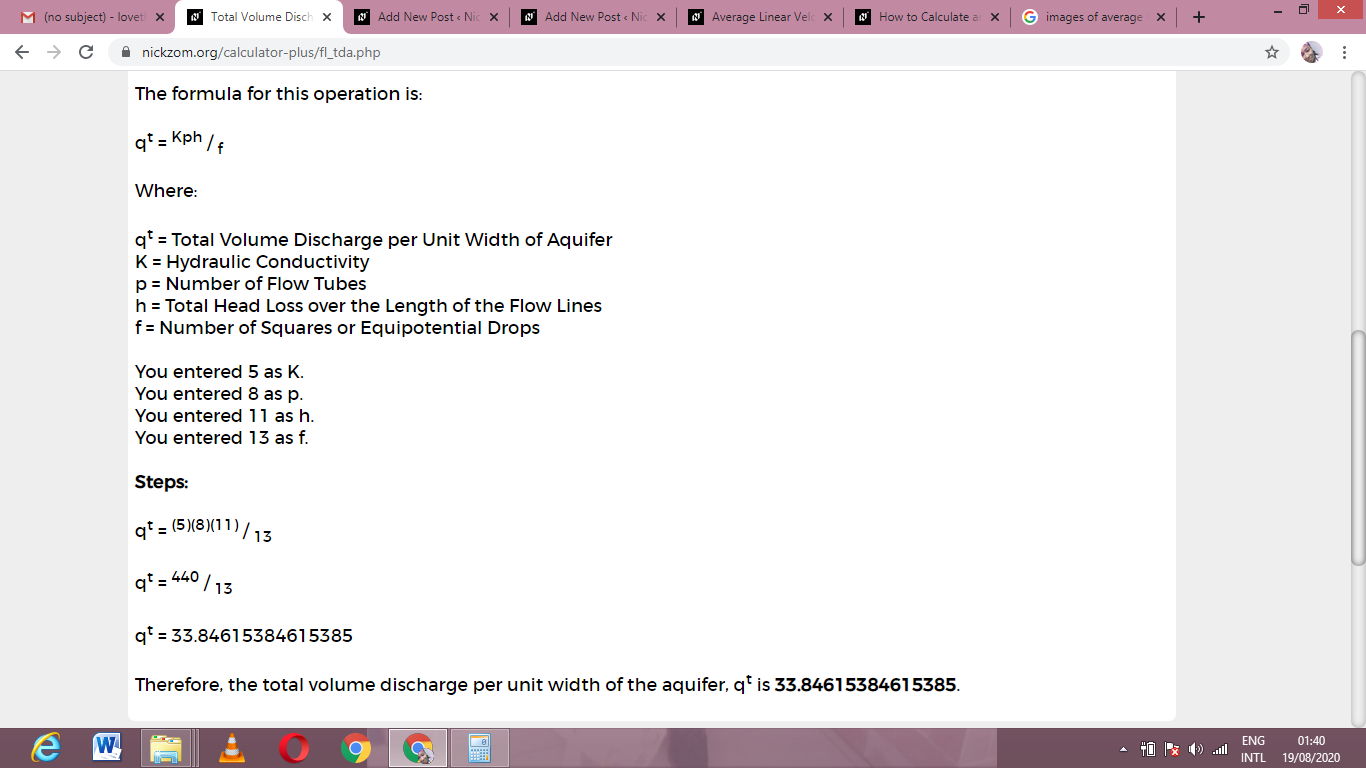How to Calculate and Solve for Total Volume Discharge per Unit Width of Aquifer | Flow Lines
Last Updated on April 7, 2024
The image above represents total volume discharge per unit width of aquifer. To calculate total volume discharge per unit width of aquifer, four essential parameters are needed and these parameters are Hydraulic conductivity (k), Number of flow tubes (p), Total Head Loss over the Length of the Flow Lines (h) and Number of Squares or Equipotential Drops (f).
The formula for calculating total volume discharge per unit width of aquifer:
qt = Kph / f
Where:
qt = Total Volume Discharge per Unit Width of Aquifer
K = Hydraulic Conductivity
p = Number of Flow Tubes
h = Total Head Loss over the Length of the Flow Lines
f = Number of Squares or Equipotential Drops
Let’s solve an example;
Find the total volume discharge per unit width of aquifer when the hydraulic conductivity is 5, the number of flow tubes is 8, total head loss over the length of the flow lines is 11 and the number of squares or equipotential drops is 13.
This implies that;
K = Hydraulic Conductivity = 5
p = Number of Flow Tubes = 8
h = Total Head Loss over the Length of the Flow Lines = 11
f = Number of Squares or Equipotential Drops = 13
qt = Kph / f
That is, qt = (5)(8)(11) / 13
qt = 440 / 13
qt = 33.84
Therefore, the total volume discharge per unit width of aquifer is 33.84.
Calculating the Hydraulic Conductivity when the Total Volume Discharge per Unit Width of Aquifer, the Number of Flow Tubes, Total Head Loss Over the Length of the Flow Lines and Number of Squares or Equipotential Drops are Given.
k = qt x f / ph
Where;
K = Hydraulic Conductivity
qt = Total Volume Discharge per Unit Width of Aquifer
p = Number of Flow Tubes
h = Total Head Loss over the Length of the Flow Lines
f = Number of Squares or Equipotential Drops
Let’s solve an example;
Find the hydraulic conductivity when the total volume discharge per unit width of aquifer is 20, the number of flow tubes is 5, the total head loss over the length of the flow lines is 4 and the number of squares or equipotential drops is 2.
This implies that;
qt = Total Volume Discharge per Unit Width of Aquifer = 20
p = Number of Flow Tubes = 5
h = Total Head Loss over the Length of the Flow Lines = 4
f = Number of Squares or Equipotential Drops = 2
k = qt x f / ph
That is, k = 20 x 2 / 5 x 4
k = 40 / 20
k = 2
Therefore, the hydraulic conductivity is 2.
Read more: How to Calculate and Solve for Transmissivity | Aquifer Characteristics
Calculating the Number of Flow Tubes when the Total Volume Dishcharge per Unit Width of Aquifer, the Hydraulic Conductivity, Total Head Loss Over the Length of the Flow Lines and the Number of Squares or Equipotential Drops are Given.
p = qt x f / kh
Where;
p = Number of Flow Tubes
qt = Total Volume Discharge per Unit Width of Aquifer
K = Hydraulic Conductivity
h = Total Head Loss over the Length of the Flow Lines
f = Number of Squares or Equipotential Drops
Let’s solve an example;
Find the number of flow tubes when the total volume discharge per unit width of aquifer is 32, the hydraulic conductivity is 7, the total head loss over the length of the flow lines is 6 and the number of squares or equipotential drops is 9.
This implies that;
qt = Total Volume Discharge per Unit Width of Aquifer = 32
K = Hydraulic Conductivity = 7
h = Total Head Loss over the Length of the Flow Lines = 6
f = Number of Squares or Equipotential Drops = 9
p = qt x f / kh
So, p = 32 x 9 / 7 x 6
p = 288 / 42
p = 6.86
Therefore, the number of flow tubes is 6.86.
Read more: How to Calculate and Solve for Average Linear Velocity | Aquifer Characteristics
Calculating the Total Head Loss Over the Length of the Flow Lines when the Total Volume Discharge per Unit Width of Aquifer, the Hydraulic Conductivity, the Number of Flow Tubes and the Number of Squares or Equipotenial Drops are Given
h = qt x f / kp
Where;
h = Total Head Loss over the Length of the Flow Lines
qt = Total Volume Discharge per Unit Width of Aquifer
K = Hydraulic Conductivity
p = Number of Flow Tubes
f = Number of Squares or Equipotential Drops
Let’s solve an example;
Find the total head loss over the length of the flow lines when the total volume discharge per unit width of aquifer is 14, the hydraulic conductivity is 10, the number of flow tubes is 4 and the number of squares or equipotential drops is 12.
This implies that;
qt = Total Volume Discharge per Unit Width of Aquifer = 14
K = Hydraulic Conductivity = 10
p = Number of Flow Tubes = 4
f = Number of Squares or Equipotential Drops = 12
h = qt x f / kp
That means, h = 14 x 12 / 10 x 4
h = 168 / 40
h = 4.2
Therefore, the total head loss over the length of the flow lines is 4.2.
Calculating the Number of Squares or Equipotential Drops when the Total Volume Discharge per Unit Width of Aquifer, the Hydraulic Conductivity, the Number of Flow Tubes and the Total Head Loss Over the Length of the Flow Lines are Given
f = kph / qt
Where;
f = Number of Squares or Equipotential Drops
qt = Total Volume Discharge per Unit Width of Aquifer
K = Hydraulic Conductivity
p = Number of Flow Tubes
h = Total Head Loss over the Length of the Flow Lines
Let’s solve an example;
Find the number of squares or equipotential drops when the total volume discharge per unit width of aquifer is 26, the hydraulic conductivity is 14, the number of flow tubes is 21 and the total head loss over the length of the flow lines is 17.
This implies that;
qt = Total Volume Discharge per Unit Width of Aquifer = 26
K = Hydraulic Conductivity = 14
p = Number of Flow Tubes = 21
h = Total Head Loss over the Length of the Flow Lines = 17
f = kph / qt
f = 14 x 21 x 17 / 26
So, f = 4998 / 26
f = 192.2
Therefore, the number of squares or equipotential drops is 192.2.
How to Calculate Total Volume Discharge per Unit Width of Aquifer | Flow Lines Using Nickzom Calculator
Nickzom Calculator – The Calculator Encyclopedia is capable of calculating the total volume discharge per unit width of aquifer.
To get the answer and workings of the total volume discharge per unit width of aquifer using the Nickzom Calculator – The Calculator Encyclopedia. First, you need to obtain the app.
You can get this app via any of these means:
Web – https://www.nickzom.org/calculator-plus
To get access to the professional version via web, you need to register and subscribe for NGN 2,000 per annum to have utter access to all functionalities.
You can also try the demo version via https://www.nickzom.org/calculator
Android (Paid) – https://play.google.com/store/apps/details?id=org.nickzom.nickzomcalculator
Android (Free) – https://play.google.com/store/apps/details?id=com.nickzom.nickzomcalculator
Apple (Paid) – https://itunes.apple.com/us/app/nickzom-calculator/id1331162702?mt=8
Once, you have obtained the calculator encyclopedia app, proceed to the Calculator Map, then click on Geology under Add-on.
Now, Click on Flow Lines under Geology
Now, Click on Total Volume Discharge Per Unit Width of Aquifer under Flow Lines
The screenshot below displays the page or activity to enter your values, to get the answer for the total volume discharge per unit width of aquifer according to the respective parameters which are the Hydraulic conductivity (k), Number of flow tubes (p), Total Head Loss over the Length of the Flow Lines (h) and Number of Squares or Equipotential Drops (f).
Now, enter the values appropriately and accordingly for the parameters as required by the Hydraulic conductivity (k) is 5, Number of flow tubes (p) is 8, Total Head Loss over the Length of the Flow Lines (h) is 11and Number of Squares or Equipotential Drops (f) is 13.
Finally, Click on Calculate
As you can see from the screenshot above, Nickzom Calculator– The Calculator Encyclopedia solves for the total volume discharge per unit width of the aquifer and presents the formula, workings and steps too. And that’s how to Calculate and Solve for Total Volume Discharge per Unit Width of Aquifer.


